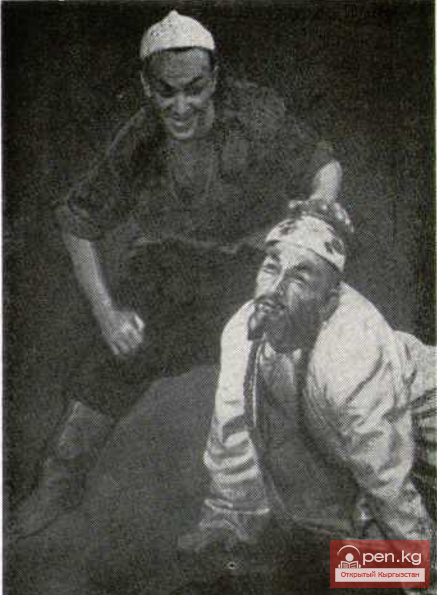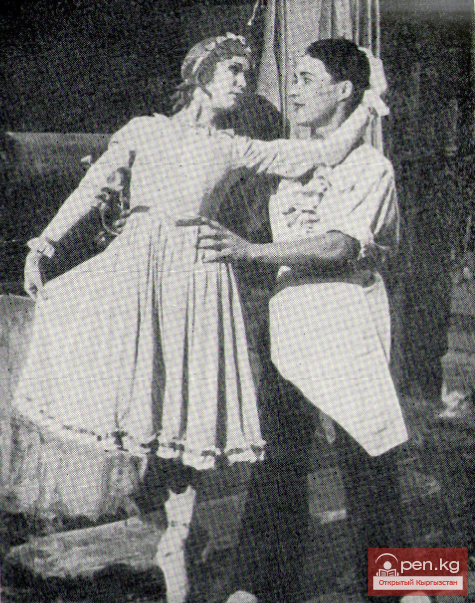
Reina Chokoeva's Roles
After Giselle, Reina Chokoeva prepared the role of Marin in the ballet "The Fountain of Bakhchisarai" by B. Astafiev (before her, this role was performed in the Kyrgyz theater by B. Beishenaliev and Ch. Djamanova).
For Chokoeva-Marin, it is characteristic to strive not only for technical mastery of the role but also to infuse it with significant intellectual content, revealing the subtext of Pushkin.
Outwardly, Reina may not resemble Maria. She spent many hours in front of the mirror to master the makeup that would recreate the appearance of Marin as we imagine it based on A. S. Pushkin's description.
However, external resemblance is far from everything for a stage image. R. Chokoeva tried to penetrate the inner world of the heroine, highlighting qualities inherent in the character of a noble Polish noblewoman. She maintained a steady demeanor, perhaps even overly proud for a captive. Especially in scenes with Girey. Weak compared to the authoritative and strong Girey, she, however, did not appear pitiful. In her attempts to escape from his embrace, the ballerina emphasized not only determination but also disdain. And even when Siren grabbed her, she lifelessly wrote on his hands, demonstrating her indifference to him.
In the climactic third act, two contradictory characters collide — Maria and Zarema. In response to the storm of emotions raging in Zarema, Maria-Chokoeva initially looks at her fearfully, then again withdraws into her sadness. While Zarema is all urgency, Maria visibly withers before our eyes. But this is by no means submission — rather, it is indifference born of despair. Maria is ready to offer her breast to Zarema's dagger but will not show her weakness.
Reina Chokoeva managed to convey the tragic situation so expressively because Maria's experiences became her own. And the sincerity with which she performed the role defined the perfection of the dance. Its concise, vivid language made one experience the dramatic fate of a proud woman, unbowed by a hateful force.
In 1961, several leading ballerinas of the theater, including R. Chokoeva, were offered the central role of Sarin in the ballet "On the Path of Thunder" by Kara Karayev. The theme of racial discrimination, vividly expressed in the ballet, is deeply understood and hated by the Kyrgyz actress, whose people have experienced everything that modern colonizers bring to small nations in the past.
In a colonial world where even love is attempted to be shackled with steel handcuffs, the love of Sari and Lenny is a protest against violence. And although both know what awaits them, they do not retreat. A person can be killed. But love cannot be destroyed. And as long as it lives, neither threats, nor whips, nor the wild rage of racists are frightening. As Sari's attraction to the colored youth Lenny grows, she simultaneously feels joy and fear about her feelings. The ballerina strives to show that the evolution of her heroine's views occurs not only because of love. She has understood much of what she did not know before and what she now confronts. Thus, her enlightenment occurs.
There is also a specific feature in the performance of the role of Sari by the Kyrgyz ballerina. For example, if for N. M. Dudin's Sari is an image of a contemporary, for the Kyrgyz actress, it is both present and past.
One generation separates today's Kyrgyz woman from the time when her people, like other peoples on the fringes of Tsarist Russia, experienced oppression and violence in full measure. This is a living history that cannot be forgotten. That is why Reina Chokoeva's suffering as Sari and her struggle are so close and understandable. This is where the optimism and humanistic resonance of the image of Sari, created on the Kyrgyz stage by R. Chokoeva, lies.
In Chokoeva's dance, the images of Cholpon and Zeynep, Giselle and Odette, Aurora ("Sleeping Beauty") and Maria ("The Fountain of Bakhchisarai") found their embodiment. Sari ("On the Path of Thunder") and Laurensia, Medora and Gyulnar ("The Corsair"). What a variety of characters and types!
For ten years, the name Reina Chokoeva — soloist of the Kyrgyz Academic Theater of Opera and Ballet — resonated in the world of art. Audiences in Moscow, Leningrad, Riga, Tashkent, Almaty, and Krasnoyarsk became acquainted with her talent. She performed in Bucharest and was a participant in the dance festival in Cuba, representing the ballet art of the Soviet Union. Cuban newspapers wrote about the ballerina's successes.
R. Chokoeva was young, energetic, and full of new creative ideas. Enriched by experience and having reached true maturity — this is how the People's Artist of the Republic Reina Chokoeva entered the second decade of her creative career.
R. Chokoeva's Work on the Role of Giselle












































